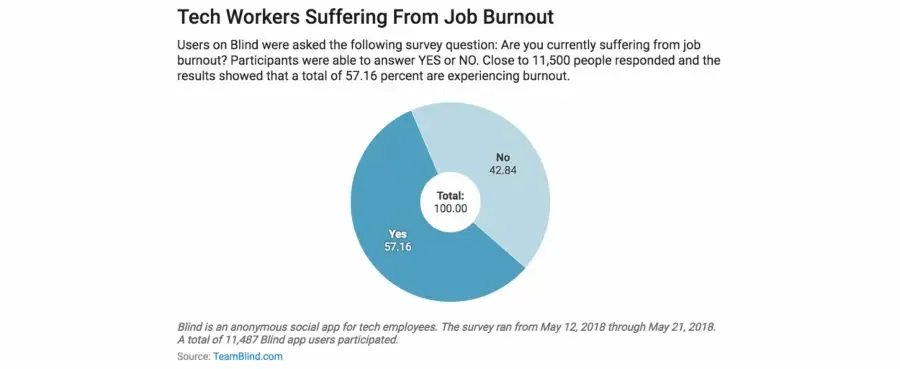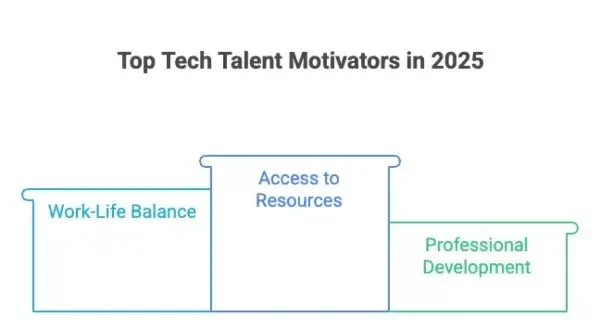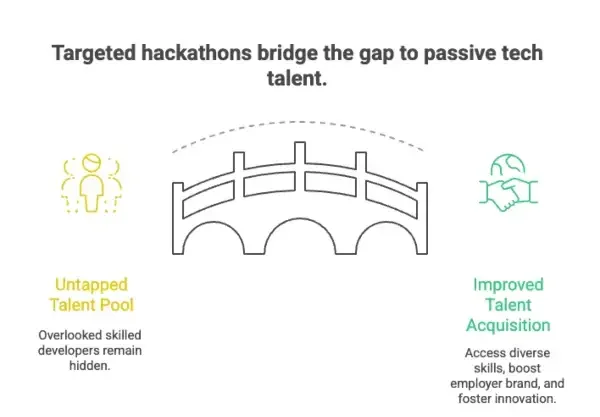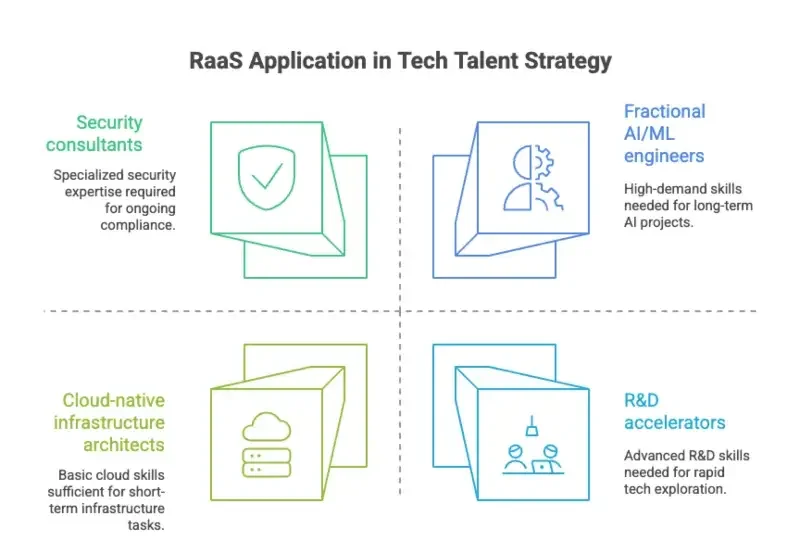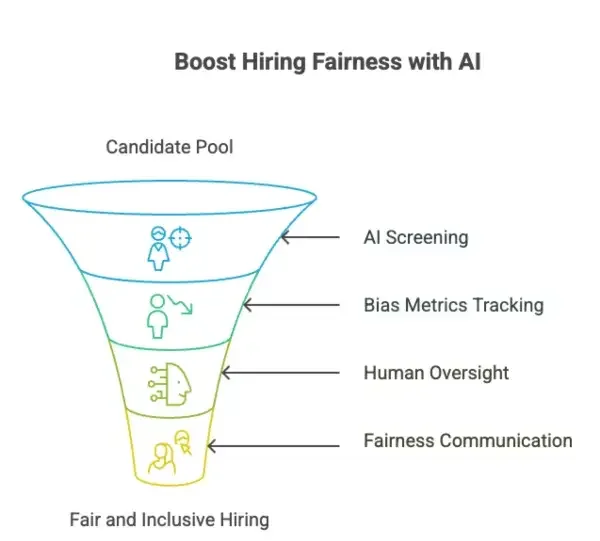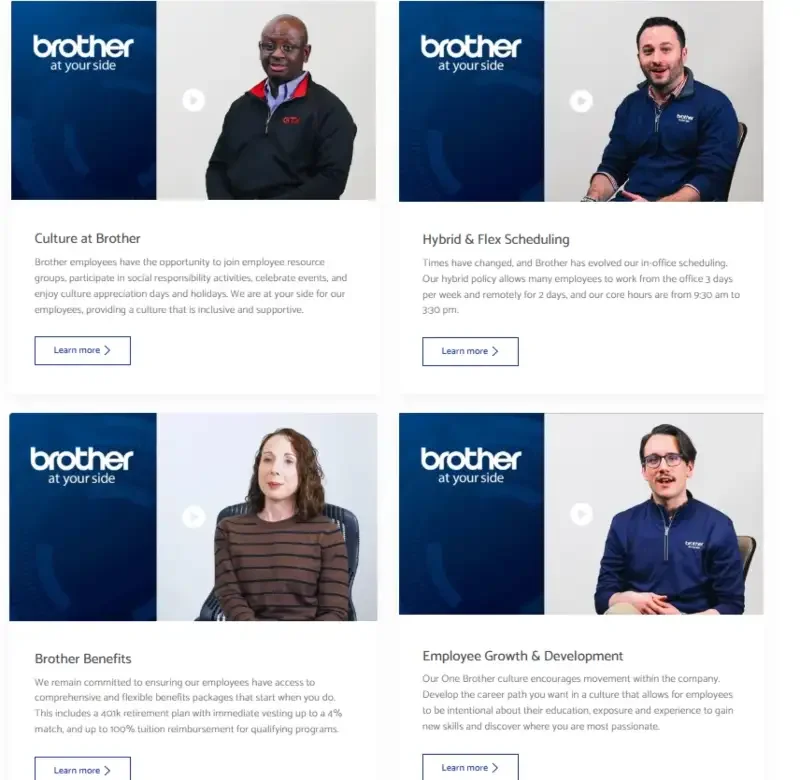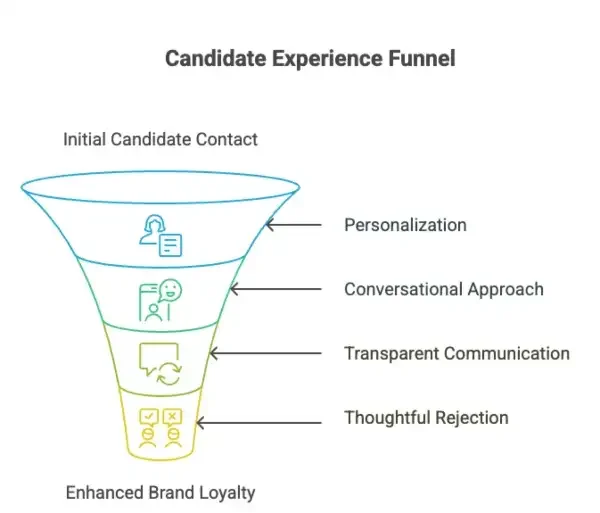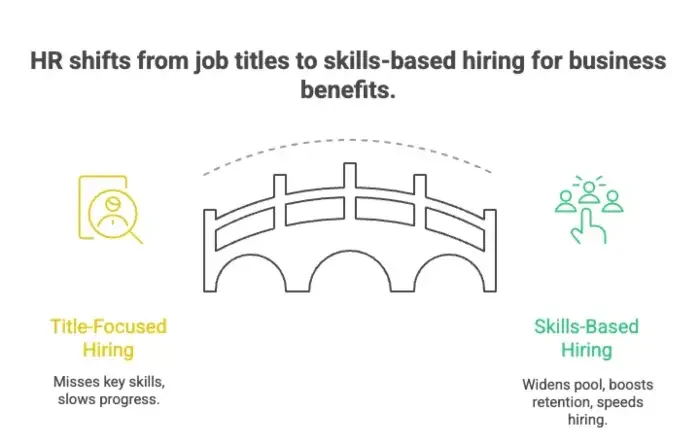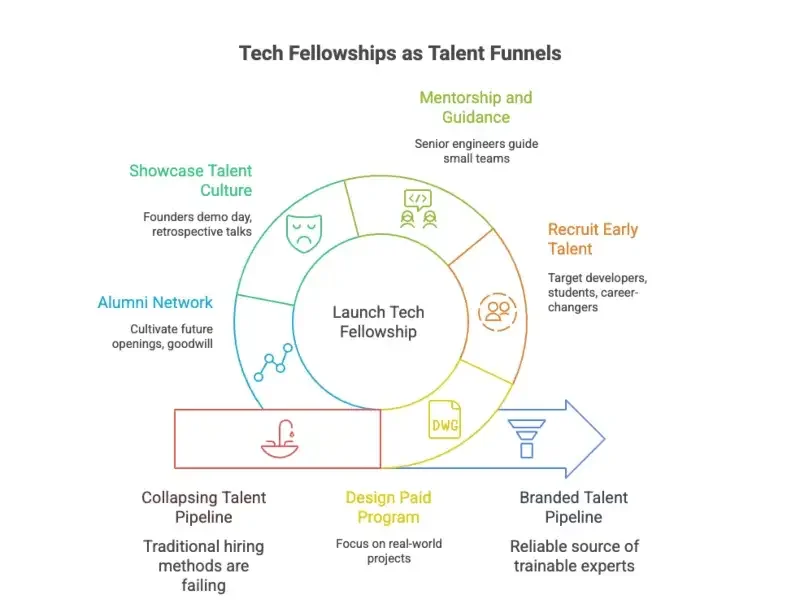8 Tech Talent Acquisition Strategies That Work In 2025
Are you hiring tech talent in 2025? If so, you’re competing for algorithmic artists who can train multimodal AI, quantum engineers, and infrastructure maestros. Plus, your competition is likely offering everything from access to rare GPUs to mini-residencies in advanced labs.
This is a strategic, high-stakes arena where you want to get ahead of that competition.
So, let’s:
Break down more of what’s changed in 2025 and how we’ll beat this at the talent acquisition game.
Discuss 10 talent acquisition strategies that dive into the current state of tech hiring.
Show you the concrete steps to get ahead and bring the right pros on board on 2025.
Keep reading below.
The 2025 Tech Talent Context
Hiring in tech has never been easy, but in 2025, there are brand new challenges to contend with. The roles are more specialized, the competition is more global, and candidate expectations are sky-high.
Let’s break down what’s shaping the battlefield this year.
1. Roles Are Evolving, And Fast
The hottest tech roles today are very niche:
AI/ML engineers who can fine-tune multimodal models
Cybersecurity specialists skilled in zero-trust, Microsoft Advanced Threat Protection (ATP), and post-quantum cryptography
Cloud-native infrastructure experts fluent in container orchestration, observability stacks, and edge deployments
Data professionals who can work with synthetic data, federated learning, and privacy-preserving pipelines
These experts aren’t easy to find, and when you do find them, they’re likely juggling 3–5 offers at any given time.
In fact, a McKinsey study found that in Europe, demand for tech talent could be 2 to 4 times higher than supply, with a gap stretching up to 3.9 million workers by 2027. That’s an entire workforce shortage looming on the horizon.
Basically, the supply is still falling short.
Job ads aren’t cutting it anymore, so talent acquisition has become harder. The marginal wins come from:
Offering rare experiences (like GPU time or "fellowship perks")
Running events that reveal raw talent
Building pipelines from within
2. AI Is Fueling the Fire
Despite fears of AI replacing jobs, it’s actually creating more demand for tech workers.
The Linux Foundation reports that organizations are using AI in critical areas like software development (54%), data analytics (52%), and infrastructure monitoring (45%). Besides, 91% of organizations offering AI training say it’s effective at retaining talent.
This AI tooling requires people who understand it, manage it, and build with it. However, the lack of in-house expertise remains a major barrier.
3. Candidate Expectations Are Non-Negotiable
The top candidates in 2025 expect:
Flexible or remote-first work models (at least six in ten do, according to Gallup)
Access to cutting-edge tools and infrastructure
A mission they can get behind. The benefit here is that 73% of people who work for a purpose-driven company are engaged. And that engagement reflects directly on your ROI.
Clear paths for growth, mentorship, and purpose-driven work
If your offer doesn’t hit most of those boxes, your ideal employees are probably moving on to another job offer.
4. Global Competition Has No Off Switch
In a global, remote-ready world, you’re not just competing with the firm down the street. In 2025, you’re going head-to-head with tech firms in Singapore, Berlin, Bangalore, and Austin.
Everyone’s hiring remote now, and the market never sleeps.
The Biggest Tech Talent Acquisition Challenges in 2025
If hiring tech talent in 2025 feels harder than ever, that’s because it is. The problems go beyond "not enough résumés in the pile." We’re talking deeper, structural challenges that are reshaping how top candidates are sourced, wooed, and won.
Let’s look at the big ones.
1. The Skill Mismatch Is Brutal
You might be getting plenty of applicants, but few with the right skills. Today’s projects demand:
Engineers who can integrate LLMs into production environments
Cloud professionals who know how to optimize for both speed and carbon footprint
Full-stack developers fluent in niche stacks or low-code tools that didn’t even exist 2 years ago
The supply just isn’t keeping up with the specialization.
2. Salary Expectations Keep Climbing
Between inflation, skill shortages, and remote global competition, salary bands are blowing up.
Top-tier AI engineers can command seven-figure packages at big players, and even mid-tier tech roles are pushing past traditional comp ranges. Your budget needs to stretch, or your offer needs to stand out in other ways.
According to the Bureau of Labor Statistics, here’s the 2024 median salary from lowest to highest:
| Role | 2024 Median Pay |
|---|---|
| Computer Support Specialists | $61,550 |
| Web Developers and Digital Designers | $95,380 |
| Network and Computer Systems Administrators | $96,800 |
| Computer Programmers | $98,670 |
| Computer Systems Analysts | $103,790 |
| Database Administrators and Architects | $123,100 |
| Information Security Analysts | $124,910 |
| Computer Network Architects | $130,390 |
| Software Developers, Quality Assurance Analysts, and Testers | $131,450 |
| Computer and Information Research Scientists | $140,910 |
3. Employer Brand Still Isn’t Cutting Through
Your careers page might look good, but if it doesn’t tell your story clearly (your mission, tech challenges, culture, and growth path), it won’t move the needle.
Candidates in 2025 are savvy. They’ll judge you by:
What employees say online
Who you’ve promoted internally
Whether your tech stack is interesting enough to work on
And if you don’t show that clearly and authentically, you’re going to struggle. So, here’s a quick explainer video that can help you get started from that standpoint:
4. The Process Is Too Slow
Every day you delay is a risk. After all, great tech candidates are off the market in days. But for many companies internal approvals take forever, hiring panels are too big, and offers go out too late.
Remember that speed doesn’t mean rushing, though; it means being ready to act decisively.
At Alpha Apex Group, here are some of our stats:
However, we also improve cost effectiveness by 50-70% compared to other models.
And we’re sure that our tech candidates will perform well in your company. That’s why we offer a 90-day replacement guarantee.
5. Global and Remote Talent Adds Complexity
Remote work is a blessing and a curse. You’ve got access to talent anywhere, but time zones can wreck interview momentum, and cultural alignment takes more work and care.
Besides, local labor laws, tax issues, and compliance can slow hiring.
For example, in California, you must reimburse your employees with a reasonable sum for internet expenses:
Without the right systems, remote hiring can quickly turn into chaos.
6. Burnout and Retention Are Real Threats
Even if you do land great talent, keeping them is another story.
Tech burnout is close to 60%, especially in AI and cybersecurity roles.
If your company isn’t proactive about mental health, sustainable workloads, and ongoing learning and growth, you’ll end up in a constant loop of hiring and replacing.
These challenges aren’t going away. But with the right strategies, they’re beatable. And that’s exactly where we’re headed next.
Our 8 In-House Tech Talent Acquisition Strategies
Without further ado, here’s what we advise you to consider if you’re trying to attract more tech talent:
1. Sell More Than Salary: Sell Compute, IP, and Access
In 2025, top-tier tech talent, especially those in AI, ML, and advanced engineering domains, is less motivated by just money.
They want access to resources that boost their impact and mastery. That could be exclusive GPU access, unique datasets, or institutional support for publishing and innovation.
Why Compensation Beyond Salary Works
First, your competition is probably doing it, and quite successfully so.
A recent labor market study showed that AI-related roles are twice as likely to include parental leave and almost three times more likely to offer remote working options, even after accounting for industry and educational differences. AI roles offering these perks tend to pay 12–20% more than comparable roles without them
And non-monetary perks matter big time.
A peer-reviewed academic study focusing on retaining niche IT professionals concluded that work-life balance, organizational culture, and professional development opportunities are critical drivers in retaining and attracting highly skilled tech talent.
These numbers tell us: access and culture can be as compelling as compensation, and sometimes even more so.
What This Looks Like in Practice
Offer access to premium infrastructure: Think “X hours/month on direct‑attached H100 GPUs” or entry to internal high-performance compute clusters.
Promote mission-led creative avenues: Support publication in high-status conferences, open-source contributions, or intellectual property development under your brand.
Bundle meaningful perks: Flexible schedules, R&D stipends, parental leave, and remote-first setups can be magnets for talented professionals.
Use these offerings strategically in your pitch: Instead of making it all about money, lead with "Here's how we help you make real breakthroughs."
2. Run Targeted Hackathons for Passive Talent
As well as being fun team-building marathons, hackathons are secret weapons for finding tech talent nobody’s setting their sights on yet. These focused, challenge-based events can be a fantastic way to connect with skilled new team members.
Why Targeted Hackathons Work in 2025
Traditional interviews test theory, but hackathons show you how someone actually solves realistic tech problems under pressure, together with teammates, in real time.
Like so:
Hosting or sponsoring hackathons also boosts your employer brand. After all, you’re creating visibility among tech communities and sparking organic conversations outside of job boards.
Here’s one standout example.
A company hosting an affirmative hackathon focused on developers with disabilities brought in 10 new hires and added 146 candidates to their talent pipeline within a single event.
When done internally, hackathons drive creativity, increase skills, boost well-being, and strengthen company culture. Your employees learn to move fast and collaborate better, which leads to solid benefits that go far beyond recruiting.
How to Make Hackathons Work for You
Define the challenge around your tech priorities: Build hackathons targeting your stack, innovation needs, or culture. For example, you can think of securing AI systems for fintech or building low-latency cloud features.
Broadcast to the right crowds: Reach passive, engaged talent in niche forums, tech meetups, and developer communities. Open events attract diverse skill sets and fresh perspectives.
Design for inclusion (it pays off): Build events for underrepresented groups, like the disability-focused example above. The result here can be stronger diversity (which leads to 39% outperformance, according to Forbes), meaningful hires, and a standout employer reputation.
Build bridges post-event: Identify standouts early and invite finalists for deeper interviews or mini-projects. This keeps momentum going and turns inspiration into offers.
3. Use Resource‑as‑a‑Service (RaaS) for Elastic Talent
When building cutting-edge tech, sometimes a full-time hire isn’t what you need. Instead, you need the right expert at the right time, for a specific job. That’s where RaaS steps in.
Here’s a bit more about RaaS as it stands today and its future:
Why RaaS Delivers Big ROI in 2025
With RaaS, you can tap into global experts in areas like quantum infrastructure, advanced security protocols, or LLM orchestration, exactly when you need them. Basically, there’ no full-time commitment.
This means you can say goodbye to sunken time and money on hiring for short-lived projects. RaaS lets you pay only for what you truly use.
Let’s say you need rapid prototyping or proof-of-concept work. RaaS lets you accelerate without warping your organizational structure or hiring pipeline.
Although industry research on RaaS in recruitment is still emerging, we can already see why it’s gaining traction when we look at broader talent trends. Modern hiring is moving away from fixed roles and toward skills-first approaches.
In fact, a comprehensive study analyzing about 11 million UK job listings between 2018 and mid-2024 found:
AI‑focused roles grew by 21% as a share of total postings.
The requirement for university degrees in AI roles dropped by 15%.
AI talent commands a 23% wage premium for skills, even above PhD-level degree value.
The pattern is clear: employers want fast, flexible access to skills that can move the business forward. Gone are the days of rigid, predefined roles.
That’s exactly what RaaS provides: the ability to tap the right skills on demand, as needed, without being locked into permanent hires.
What RaaS Can Look Like for Tech TA in 2025
Fractional AI/ML engineers for sprint projects or model tuning
Cloud-native infrastructure architects on demand for migrations or optimization
Security consultants who plug into your team for audits or compliance bursts
R&D accelerators for emerging tech exploration, like edge computing or privacy-preserving AI
4. Apply Bias‑Aware AI to Screen Fairly
In 2025, pipelines overflowing with qualified candidates mean it's extra important to evaluate them fairly and efficiently. Bias-aware AI tools can help level the field here and make your hiring smarter and more inclusive.
Why Bias‑Aware AI Screening Is Important
AI doesn’t replace humans in hiring, but rather complements them well. One essential feature is that it helps us unravel our unconscious biases.
Science backs this up.
A recent study found that AI-driven systems reduced sentiment-based interviewer bias by 41.2%. That’s extremely important because it’s reshaping early-stage evaluations to be more equitable and focused on actual skills.
How to Put This Into Action
At Alpha Apex Group, we use AI for hiring, too. To avoid biases, we follow these four simple steps:
Plug into tools that filter fairly: Use AI screening systems that focus on abilities rather than tone, background, or unconscious markers. Look for tools that are specifically designed to mitigate biases tied to gender, race, or cultural phrasing.
Set measurable bias metrics: Track how different candidate groups advance through your funnel. AI tools should help you monitor disparities in progression rates and outcomes.
Blend fairness with human oversight: AI should support rather than replace human judgment. Pair AI screening with structured human panels to make sure fairness and contextual understanding go hand-in-hand.
Communicate the fairness advantages: Highlight your bias-aware tools in your job descriptions or recruiting materials. This signals your commitment to equity and the fairness of your process to all job applicants.
5. Craft Hiring Experiences That Engage People
In 2025, tech candidates are going to be judging every touchpoint in your hiring process. And if it feels like a slog or a black box, you’ve already lost them. The experience you create from first contact to final offer has the power to convert… and just as easily, to repel.
What’s more, the data backs it up.
A recent survey showed that new hires who had an exceptional candidate experience are:
3.2 times as likely to strongly feel like they are connected to their organization’s culture.
3 times as likely to be extremely satisfied with their work.
So how do you create an experience that actually delights?
From our experience, personalization is everything.
Have a hiring manager or future teammate record a short video welcoming candidates and sharing what excites them about the work. Or create a private microsite where each candidate can explore your team culture, check out real projects, and get a feel for the challenges they'd be solving.
Many companies have upgraded their career pages or career microsites with testimonials, videos, culture content, etc. For instance, Brother International Corporation revamped their career site to include employee stories, videos, and better showcase their values.
This isn’t a private microsite for each candidate, but they do implement the type of content you’re wanting here:
Pro tip: Make it conversational, not transactional.
Invite candidates to a low-pressure chat with a senior engineer or DevOps lead, framed around solving real problems instead of regurgitating textbook answers. Be transparent at every step. Tell them what to expect, when to expect it, and stick to it. Thoughtful communication builds trust, and silence breaks it.
Even rejection can be part of the delight strategy.
Don’t just send a generic “thanks but no thanks.” Instead, offer a sincere note of appreciation, a few specifics about what impressed you, and an open door for future roles. That kind of experience leaves a lasting impression, even when things don’t go their way.
Remember that delight is about treating candidates like real humans. When done right, it boosts your brand, improves your close rate, and lays the foundation for long-term loyalty.
6. Prioritize Critical Skills Over Job Titles
In 2025, job titles have become old news. The real game is about owning the right skills. If HR leaders and tech execs still anchor hiring around "Senior Engineer" or "DevOps Lead," they’re missing the mark.
Candidates with titles might check boxes, but candidates with the skills that actually matter will move your business forward faster.
What’s fueling this shift?
As we mentioned earlier, demand for AI roles has grown significantly, yet formal university degree requirements for these roles has actually dropped. And AI skills now carry a wage premium of 23%, which outperforms degree-based premiums even up to PhD-level.
That means employers are explicitly paying more for demonstrated abilities over pedigrees.
What’s more, modern recruiting strategies reflect this change.
One hiring report noted a surge in skills-based hiring, with 81% of employers adopting a skills-first approach in 2024, up from 56% just two years prior, which shows just how quickly companies are rethinking what qualifies someone to do the job.
In fields like AI, cloud automation, or cybersecurity, practical ability is everything.
You want someone seasoned in LLM fine-tuning, helping secure zero-trust architectures, or optimizing edge deployments. In other words, demonstrable concrete skills and experience matter more than certificates.
To make this shift real, you need to reshape your headlines, descriptions, and expectations.
Instead of "Senior Backend Engineer needed," say "We're hunting for someone who's built scalable microservices handling 10M+ requests per minute across AWS and GCP." That change in framing alone sharpens who applies and raises your odds of hitting gold.
The business benefits are clear. Skills-based hiring widens your candidate pool and speeds up hiring, while also boosting retention. When people are evaluated for, and succeeding in, what they actually do, engagement and performance tend to follow.
7. Get Your CTO or VPs Involved in Outreach
Emails from "hr@[company]" barely register in today's crowded inboxes. That's why in 2025, having someone like your CTO, VP of Engineering, or technical lead reach out personally can make a world of difference. These candidates want to connect with peers who truly understand their work and can convince them that this role truly matters.
Here’s the cold, hard truth:
More than half of workers report landing jobs thanks to personal or professional connections. In a recent survey, 32% credited personal contacts, while an additional 28% pointed to professional connections as the most helpful job search strategy, far surpassing job boards (13%) or recruiters (8%).
That means your senior leadership can play a serious role in delivering results. A note from someone who understands the tech at play, and can talk theory and ambition, resonates in ways that any HR template never could.
Here’s How to Make Executive Touch Work for Your Hiring
Kick off outreach personally: Let your CTO or VP send the first note instead of using templated HR copy. A quick line like, "I’ve been looking at your work in container orchestration and would love to chat over coffee,” can be a fantastic way to stand out.
Invite them to low-stress micro-events: Set up short “Ask Me Anything” sessions where candidates can hop onto a quick engineering chat with a senior leader. These micro-events spark trust and help candidates get a feel for your company early on.
Turn hiring into mentorship signals: Frame the conversation not as recruitment, but as a peer connection: “No agenda, just curious to see how you think about modern LLM deployments.” That peer-to-peer tone can make candidates feel validated and build trust.
Show your leadership cares: Sharing real stories, like "This is what we’re trying to build, and we need someone like you to help get there", goes way farther than a generic job ad ever could.
8. Launch a Tech Fellowship as a Funnel
In 2025, smart companies are using short-term, immersive fellowship programs as talent funnels. These are deep dives into your toughest problems, wrapped in structured learning and purpose.
Why does this work now? First, entry-level hiring is crashing.
The SignalFire State of Tech Talent Report shows that hiring new graduates has dropped over 50% since pre-pandemic levels. Big Tech now sees new grads making up just 7% of hires, and startups are even lower at around 6%. That means the traditional pipeline is collapsing.
So, if you’re not tapping into talent through unconventional paths, like fellowships, you’re missing what might soon be your only reliable source of fresh, trainable experts.
And you can take inspiration from Monks.
The company has created the S4 Fellowship Program, which offers four six-month rotations across different departments of marketing and tech, with hands-on learning and mentorship.
How a Tech Fellowship Program Works
Start by designing a 4-8 week paid program centered on a real project or domain like AI ethics, infra automation, edge compute, or quant finance. It should be structured, mentorship-heavy, and outcome-focused.
You will recruit promising early-career developers, students, or career-changers.
They should work in small teams, guided by senior engineers, on projects that matter to your product roadmap. It’s a transparent, immersive window into what working at your company looks like and you get to preview their skills, creativity, and collaborative potential up close.
What makes it powerful:
You build a branded talent pipeline on autopilot by training folks who already know your challenges
Candidates get hands-on with real systems, so conversion to full-time is smoother and more predictive
It doubles as a retention strategy. When participants have agency and meaningful work, they stay longer and contribute faster.
Putting the Tech Fellowship Strategy to Work
Frame your outreach around opportunity, growth, and mission. Invite applicants to apply to your “Fellowship in Sustainable ML Infrastructure” or “Quantum Security Sprint.” Let them know upfront it's a live challenge with mentorship, demo day, and potential fast-track to hire.
Once it’s live, invite founders or VPs to demo day or casual retrospective talks to make it a showcase of both talent and your tech culture. Participants who didn’t convert? Keep them in an Alumni Slack channel or mailing list so that you’re cultivating future openings and goodwill.
Final Thoughts: Tech Talent Acquisition in 2025 Takes More Than a Job Ad
From AI-powered screening and compute-driven compensation to executive-led outreach and immersive fellowships, the rules have changed when it comes to hiring tech talent. And the companies who win are the ones who treat talent acquisition like a product rather than a process.
The strategies we’ve explored aren’t one-size-fits-all, but that’s the point. Today’s hiring leaders need to build bespoke playbooks, grounded in real candidate needs, sharp execution, and a willingness to do things differently.
So if your current approach feels stuck, slow, or stale, don’t wait. Audit your pipeline, reframe your job specs, and try just one or two of these strategies. The best hires are choosing the companies who move fast, think smart, and make hiring feel human again.
And if you need help getting started, Alpha Apex Group is here to support you every step of the way.
With a 43-day average time-to-fill for full-time hires, an 80% placement success rate, and up to 70% cost savings, we can power your team with the right tech talent fast.
Contact us today to see how we can help.
FAQ: Hire the Best Tech Talent in 2025
What is tech sourcing?
Tech sourcing is the process of identifying and engaging potential candidates for technical roles before they apply. It’s a proactive approach, using sourcing tools, social media platforms, and data-driven insights to uncover talent in areas like software engineering, machine learning, or data science. A good sourcing strategy is crucial for filling specialized roles faster and more efficiently.
What is a sourcing strategy in tech hiring?
A sourcing strategy is your game plan for where, how, and who you'll target to fill your talent pipeline. In tech, this often includes using employee referrals, social media outreach, and specialized sourcing tools to uncover talent in machine learning, cybersecurity, or cloud architecture. A sharp strategy balances speed with quality and helps teams stay competitive.
How do social media platforms help with tech talent acquisition?
Social media is a powerful channel for finding and engaging top tech talent. Platforms like LinkedIn, Twitter (X), and even Reddit can be used to source developers, data scientists, or designers. You can share open roles, build relationships, or scout profiles that match your needs. Of course, social media is great for candidate screening, but you can also use it for programmatic advertising and even for building future talent pipelines.
What tools are essential for tech talent acquisition in 2025?
Modern recruitment relies on a strong applicant tracking system (ATS) to manage the hiring funnel, plus AI-powered sourcing tools to surface qualified candidates faster. Predictive analytics helps forecast candidate success, while Generative AI is now used for everything from writing job descriptions to automating personalized outreach. These tools streamline the recruitment process and reduce time-to-hire.
What is recruitment process outsourcing, and when should you use it?
Recruitment process outsourcing (RPO) is when a company partners with an external provider to manage some or all of its hiring operations. It’s especially useful for scaling fast, tapping into global talent, or filling hard-to-hire roles in fields like data science or machine learning. RPO teams often use advanced sourcing strategies and social media platforms to reach passive candidates more effectively.
What’s the biggest hiring challenge in tech right now?
The biggest challenge for HR professionals is the skills gap: demand for specialized skills in areas like cloud, cybersecurity, and Generative artificial intelligence far exceeds supply. This makes it harder to close roles and easier to lose candidates to faster-moving competitors. Companies that stand out are using creative tactics like employee referrals, targeted job offers, and personalized sourcing strategies to connect with the right talent before the competition does. You can also consider upskilling programs for your current employees.



